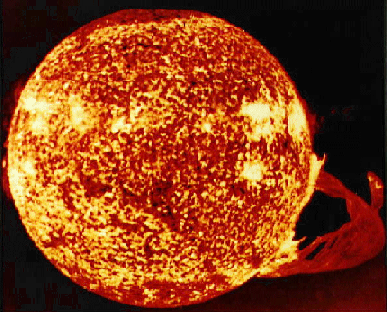
The Sun Erupts
Credit: NASA, Skylab
Discover the cosmos! Each day we feature a different image or photograph of our fascinating universe, along with a brief explanation written by a professional astronomer.
August 13, 1995

The Sun Erupts
Credit:
NASA,
Skylab
Explanation: The sun was captured in 1973 throwing one of the largest eruptive prominences ever recorded. Sol, our sun, is a normal star. It formed about 5 billion years ago, and will last about another 5 billion years. The sun will never explode, and a solar flare will never destroy the earth. Eventually the sun will become a white dwarf star. The sun is made of mostly hydrogen and helium. The sun's center is so hot that when hydrogen nuclei collide, they stick together and release energy - a process called nuclear fusion No one knows why the center of the sun emits so few neutrinos.
Tomorrow's picture: Mercury: Closest Planet to the Sun

We are proud to acknowledge that an external review by
Point Communications
has rated Astronomy Picture of the Day in the top 5 percent of all
World Wide Web sites.